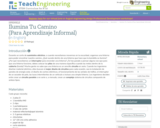
Los estudiantes construyen linternas al tiempo que aprenden sobre circuitos.
- Subject:
- Applied Science
- Engineering
- Material Type:
- Activity/Lab
- Provider:
- TeachEngineering
- Provider Set:
- Sprinkles
- Date Added:
- 01/01/2015

Los estudiantes construyen linternas al tiempo que aprenden sobre circuitos.
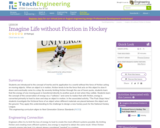
Students are introduced to the concept of inertia and its application to a world without the force of friction acting on moving objects. When an object is in motion, friction tends to be the force that acts on this object to slow it down and eventually come to a stop. By severely limiting friction through the use of the hover pucks, students learn that the energy of one moving puck is transferred directly to another puck at rest when they collide. Students learn the concept of the conservation of energy via a "collision," and will realize that with friction, energy is converted primarily to heat to slow and stop an object in motion. In the associated activity, "The Puck Stops Here," students will investigate the frictional force of an object when different materials are placed between the object and the ground. This understanding will be used to design a new hockey puck for the National Hockey League.
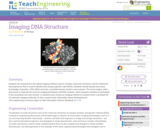
Students are introduced to the latest imaging methods used to visualize molecular structures and the method of electrophoresis that is used to identify and compare genetic code (DNA). Students should already have basic knowledge of genetics, DNA (DNA structure, nucleotide bases), proteins and enzymes. The lesson begins with a discussion to motivate the need for imaging techniques and DNA analysis, which prepares students to participate in the associated two-part activity: 1) students each choose an imaging method to research (from a provided list of molecular imaging methods), 2) they research basic information about electrophoresis.

The course is designed to provide a better understanding of the built environment, globalization, the current financial crisis and the impact of these factors on the rapidly changing and evolving international architecture, engineering, construction fields. We will, hopefully, obtain a better understanding of how these forces of globalization and the current financial crisis are having an impact on the built environment and how they will affect firms and your future career opportunities. We will also identify, review and discuss best practices and lessons that can be learned from recent events. We will explore the international built environment" in detail, examining how it functions and asking what are the managerial, entrepreneurial and professional opportunities, challenges and risks in it, especially growing crossover and multi-disciplinary opportunities; and we will seek to understand what makes this "built environment" so different from other sectors."

Students apply the design process to the problem of hiding a message in a digital image using steganographic methods, a PictureEdit Java class, and API (provided as an attachment). They identify the problems and limitations associated with this task, brainstorm solutions, select a solution, and implement it. Once their messages are hidden, classmates attempt to decipher them. Based on the outcome of the testing phase, students refine and improve their solutions.
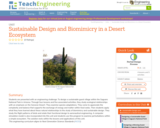
Students are presented with an engineering challenge: To design a sustainable guest village within the Saguaro National Park in Arizona. Through four lessons and six associated activities, they study ecological relationships with an emphasis on the Sonoran Desert. They examine species adaptations. They come to appreciate the complexity and balance that supports the exchange of energy and matter within food webs. Then students apply what they have learned about these natural relationships to the study of biomimicry and sustainable design. They study the flight patterns of birds and relate their functional design to aeronautical engineering. A computer simulation model is also incorporated into this unit and students use this program to examine perturbations within a simple ecosystem. The solution rests within the lessons and applications of this unit.
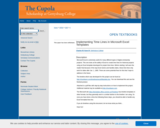
Microsoft Excel is extremely useful for many different types of digital scholarship projects. This one looks at the ability of Excel to create time lines for historical projects using an Excel template developed for project time lines. Before starting I will warn the reader that because of the way Excel stores and handles dates, these time lines only work for dates after Jan. 1, 1900. There are some potential fixes for this that I hope to address in the future.
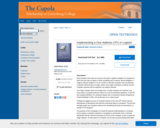
Most computer users have an incorrect, but useful, cognitive metaphor for computers in which the user says (or types or clicks) something and a mystical, almost intelligent or magical, behavior happens. It is not a stretch to describe computer users as believing computers follow the laws of magic, where some magic incantation is entered, and the computer responds with an expected, but magical, behavior.
This magic computer does not actually exist. In reality computer are machines, and every action a computer performs reduces to a set of mechanical operations. In fact the first complete definition of a working computer was a mechanical machine designed by Charles Babbage in 1834, and would have run on steam power.
Probably the biggest success of Computer Science (CS) in the 20th century was the development of abstractions that hide the mechanical nature of computers. The fact that average people use computers without ever considering that they are mechanistic is a triumph of CS designers.
This purpose of this monograph is to break the abstract understanding of a computer, and to explain a computer’s behavior in completely in mechanistic terms. It will deal specifically with the Central Processing Unit (CPU) of the computer, as this is where the magic happens. All other parts of a computer can be seen as just providing information for the CPU to operate on.
This monograph will deal with a specific type of CPU, a one-address CPU, and will explain this CPU using only standard gates, specifically AND, OR, NOT, NAND and XOR gates, and 4 basic Integrated Circuits (ICs), the Decoder, Multiplexer, Adder, and Flip Flop. All of these gates and components can be described as mechanical transformations of input data to output data, and the overall CPU can then be seen as a mechanical device.
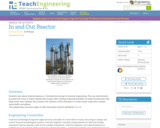
Students learn about material balances, a fundamental concept of chemical engineering. They use stoichiometry to predict the mass of carbon dioxide that escapes after reacting measured quantities of sodium bicarbonate with dilute acetic acid. Students then produce the reactions of the chemicals in a small reactor made from a plastic water bottle and balloon.
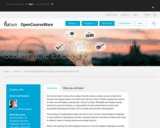
For the first time in history, the number of world citizens without access to electricity services has dropped below one billion, but still more than 2.8 billion people lack access to clean and affordable cooking fuels. Access to clean, affordable and reliable energy services for all world citizens is a precondition for the achievement of many other Sustainable Development Goals, such as health and economic development.
The provision of sustainable energy services for all is not just a technological challenge or one confined to developing countries. Industrial and post-industrial societies also need to address issues of energy poverty and energy injustice.
Rather than tackling the technological dimension of the formidable challenge to provide an inclusive energy system with renewable and climate-neutral energy resources, this course will focus on its social and institutional dimension. Introduction to the principle of the 4 As of energy services – Accessibility, Availability, Affordability, and Acceptability (environmental and social) will enrich your perspective as an engineering professional. Balancing these four critical and interdependent criteria is a recurrent challenge for individuals and society as a whole, as the characterization of the four As evolves with economic development and changing societal preferences.
You will learn how the rules of the game as defined in laws, regulation and market designs impact the balance between the 4As. Using a wider socio-technical systems perspective you will discover new solutions for the inclusive provision of energy services beyond the purely technological solutions.
After this course you can engage in a richer, more informed debate about how to achieve an inclusive energy system. You will be able to translate this knowledge into strategies to serve society’s future energy needs. The cases presented from developed and developing countries will help you to develop and test your analytical skills. Interviews with industry leaders shaping the energy system will challenge you to reflect on the position these leaders take and the interests they serve.
Lastly, you will put yourself to the test by demonstrating your newly acquired knowledge and skills as a strategic policy advisor, in writing guidelines for a strategic action plan for the energy system and institutional context which are relevant for you, in your company, your city or your country.
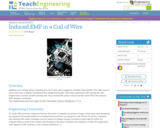
Students use a simple set up consisting of a coil of wire and a magnet to visualize induced EMF. First, students move a coil of wire near a magnet and observe the voltage that results. They then experiment with moving the wire, magnet, and a second, current carrying coil. Students connect the coil to a circuit and the current from the induced EMF charges a conductor.
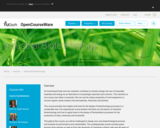
As fossil-based fuels and raw materials contribute to climate change, the use of renewable materials and energy as an alternative is increasingly important and common. This transition is not a luxury, but rather a necessity. We can use the unique properties of microorganisms to convert organic waste streams into biomaterials, chemicals and biofuels.
This course provides the insights and tools for the design of biotechnology processes in a sustainable way. Five experienced course leaders will teach you the basics of industrial biotechnology and how to apply these to the design of fermentation processes for the production of fuels, chemicals and foodstuffs.
Throughout this course, you will be challenged to design your own biotechnological process and evaluate its performance and sustainability. This undergraduate course includes guest lectures from industry as well as from the University of Campinas in Brazil, with over 40 years of experience in bio-ethanol production. The course is a joint initiative of TU Delft, the international BE-Basic consortium and University of Campinas.
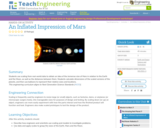
Students use scaling from real-world data to obtain an idea of the immense size of Mars in relation to the Earth and the Moon, as well as the distances between them. Students calculate dimensions of the scaled versions of the planets, and then use balloons to represent their relative sizes and locations.
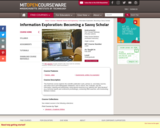
This freshman course explores the scientific publication cycle, primary vs. secondary sources, and online and in-print bibliographic databases; how to search, find, evaluate, and cite information; indexing and abstracting; using special resources (e.g. patents) and "grey literature" (e.g. technical reports and conference proceedings); conducting Web searches; and constructing literature reviews.
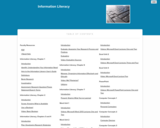
To be information literate, a person must be able to recognize when information is needed and have the ability to locate, evaluate, and use effectively the needed information. By the end of this unit you will be able to Define Information Literacy, Define the four domains that fall under Metaliterate Learners, Identify a lack of knowledge in a subject area, Identify a search topic/question and define it using simple terminology, Articulate current knowledge on a topic, Recognize a need for information and data to achieve a specific end and define limits to the information need, and Manage time effectively to complete a search.

During your studies you will frequently be asked to write a paper. For such a paper you will need information, but how do you get it? What exactly do you need? Where can you find it? How do you go about it? Almost anyone can use Google, of course, but more is expected of a TU Delft student!
We challenge you to go beyond using the popular search engines. This instruction will help you discover what there is to learn about information skills.

This instruction follows on from the online instruction Information Literacy 1, in which you learned how to find, evaluate and use information. Today’s instruction is intended for advanced users.

This collection brings together scholarship and pedagogy from multiple perspectives and disciplines, offering nuanced and complex perspectives on Information Literacy in the second decade of the 21st century. Taking as a starting point the concerns that prompted the Association of Research Libraries (ACRL) to review the Information Literacy Standards for Higher Education and develop the Framework for Information Literacy for Higher Education (2015), the chapters in this collection consider six frameworks that place students in the role of both consumer and producer of information within today's collaborative information environments. Contributors respond directly or indirectly to the work of the ACRL, providing a bridge between past/current knowledge and the future and advancing the notion that faculty, librarians, administrators, and external stakeholders share responsibility and accountability for the teaching, learning, and research of Information Literacy.

Good researchers have a host of tools at their disposal that make navigating today’s complex information ecosystem much more manageable. Gaining the knowledge, abilities, and self-reflection necessary to be a good researcher helps not only in academic settings, but is invaluable in any career, and throughout one’s life. The Information Literacy User’s Guide will start you on this route to success.The Information Literacy User’s Guide is based on two current models in information literacy: The 2011 version of The Seven Pillars Model, developed by the Society of College, National and University Libraries in the United Kingdom and the conception of information literacy as a metaliteracy, a model developed by one of this book’s authors in conjunction with Thomas Mackey, Dean of the Center for Distance Learning at SUNY Empire State College. These core foundations ensure that the material will be relevant to today’s students.The Information Literacy User’s Guide introduces students to critical concepts of information literacy as defined for the information-infused and technology-rich environment in which they find themselves. This book helps students examine their roles as information creators and sharers and enables them to more effectively deploy related skills. This textbook includes relatable case studies and scenarios, many hands-on exercises, and interactive quizzes.
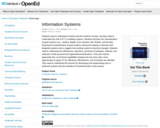
Students need to understand systems and the systems concept, and they need to understand the role of ICT in enabling systems. Students will learn the characteristics of good systems (e.g., intuitive, likable, error-resistant, fast, flexible, and the like). Knowing the characteristics of good systems will permit students to demand well designed systems and to suggest how existing systems should be changed. Students need to understand the affordances, directions, and limits of hardware, software, and networks in both personal and organizational dimensions. They also need to appreciate that, as technical capabilities change and new ones arise, more opportunities to apply ICT for efficiency, effectiveness, and innovation are afforded. They need to understand the process for developing and implementing new or improved systems and the activities of IS professionals in this process.